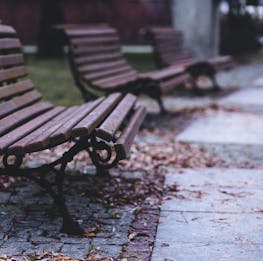The Life-Changing Magic of Tidying Up Summary
The Japanese Art of Decluttering and Organizing
Do you feel like your space and life are both getting overtaken by stuff? Well, maybe it's time to embrace the KonMari method,
The Life-Changing Magic of Tidying Up, takes us through Marie Kondo's formulaic process of tidying, decluttering, simplifying, and organizing. The promise is that if we tidy thoroughly once, we'll never experience clutter again, and our lives will change for the better in the process.
You've probably heard of the author, Marie Kondo. She's a renowned cleaning consultant, and Internet sensation. In The Life-Changing Magic of Tidying Up, Marie Kondo takes tidying to new levels, and she transforms the practice of tidying. Kondo changes the perception of tidying up, from an endless chore, to a once-off life-changing experience.
Many of us adopt the "messy-by-nature" excuse. However, we can shift our view of tidying, from a necessary daily drag, to one where we regard it as a one-off special event. Kondo is quite ruthless in her approach, and instead of tidying little-by-little or room-by-room, Kondo gives us a once-off method of decluttering. The great thing is that it's foolproof. What's more, people who complete the KonMari Method have successfully kept their house in order, and experienced positive changes in other aspects of their lives.
The unique KonMari method offers a lifetime guarantee, of being clutter-free. And, It's not just our space that will change. Kondo invites us to imagine our ideal life, where we achieve outer order, by creating inner clarity, and only keeping what "sparks joy." But, you don't mess around with Marie Kondo, to be quite literal. Her method is strict. The KonMari method has two rules. Discard first, then decide where things go.
This summary will briefly break down the KonMari method, and reveal how it can invite magic back into our lives. The two-part formula has distinct steps with practical strategies. Most importantly, Kondo highlights that tidying is more about choosing and treasuring what we keep, instead of what we throw away. The ultimate question we have to ask, when deciding what's worth keeping, is, "Does this spark joy?" And this mantra shouldn't just apply to possessions, but to how we choose to live our lives.
The Cleaning Revolution
Marie Kondo is famed for her revolutionary approach to cleaning. From the age of five, Kondo loved reading home magazines, because of the order and beauty of the well-organized spaces they depicted. This early interest further inspired her to take care of her belongings and her surrounding space. This behavior became not just a pastime, but a passion.
From the age of 15, she started studying tidying more formally, and later, during college, spent five years as an attendant maiden at a Shinto shrine. Shintoism regards cleaning and organizing things as a spiritual practice. One of the central tenets of Shintoism is concerned with the energy and divine spirit of all things, even inanimate objects. Kondo's experience at the Shrine inspired the KonMari method's evolution. She now teaches this method worldwide.
Kondo spends a lot of her time visiting homes and offices, providing a hands-on approach to people who find it challenging to tidy, or who want to be tidy but don't know where to start. Kondo views tidying as a ritualized practice, and she approaches it with a sense of reverence and formality. For example, she wears a neat dress and blouse to mark the special occasion of tidying up. One of her rituals is to greet each house when she enters. She kneels formally on the floor in the center of the home, and silently addresses the space.
After giving a brief self-introduction, she asks for help in creating a space where the family can enjoy a happier life. It's a silent ritual that only takes about two minutes. This act reflects, her respect towards others, their homes, and the art of tidying.
Kondo's ultimate goal is to help us live lives that spark joy, and she offers simple and effective tools for us to start this journey. But, you might be thinking to yourself that you do tidy up but it's not long before everything is messy again. Kondo believes that this common excuse and complaint occurs because we misguidedly believe that we've tidied thoroughly, when in fact, we've only partially sorted and stored things.
We Should View Tidying as a Subject That Can Be Taught
A lot of the problems around properly tidying are that it's not taught in schools. Subjects, such as home economics, generally teach us things like cooking, but little time is devoted to the art of tidying. Kondo says that tidying is "the job that keeps the home liveable, yet it's a self-taught job, and therein lies the problem."
From Kondo's vast experience, people who have been homemakers for over thirty years, don't tidy any better than those in their twenties. It's also clear that conventional approaches to tidying don't work, homes overflow with unnecessary items, and ineffective storage methods fail to keep clutter under control. But, we needn't be discouraged. We can escape the vicious cycle of clutter. First, though, we need to change our mindset when it comes to tidying.
Ultimately, tidying must be completed all at once, in a given period. The best way to tackle this, is to make tidying a special event. By adopting this mindset, the idea is that you need to tidy once; you don't do it every day. This approach may sound downright bizarre. However, the theory is that you won't revolve in an endless cycle of tidying up if you do it right the first time.
The problem with tidying bit by bit, is that we often don't feel the effects, or see noticeable results. And, while we may initially feel inspired, this inspiration usually doesn't last. So much about the notion of success is that it depends on experiencing tangible results immediately. Suppose we adopt the KonMari method, and focus on eliminating clutter over a short period. In that case, we'll see instant results that'll empower us to continue keeping our space in order.
There are two kinds of tidying; there's daily tidying, and there's special event tidying. Daily tidying involves using something and then putting it back in its place. This tidying method will remain the norm for as long as we live.
The purpose of The Life-Changing Magic of Tidying Up, is to tackle special event tidying. This tidying helps us put our house in order, once and for all.
The lessons about tidying are important, because it's not just about creating a pleasant environment. Tidying once, and tidying properly, brings change that's so profound, it touches us emotionally, which dramatically affects our thinking and lifestyle habits.
A Messy Space Equals a Messy Mind
The effect of a messy space is more than just physical. Cleaning is also deeply emotional, and it often highlights what's bothering us. Being surrounded by a clean and uncluttered environment encourages a state of deep self-reflection.
This self-reflection allows us to take note of issues and problems, making us deal with them head-on. Kondo reasserts the importance of tidying and says that, "from the moment you start tidying, you will be compelled to reset your life, causing it to start to shift."
So, in essence, tidying is just the tool, and the real goal is to establish a path towards our ideal lifestyle. Putting our homes in order helps to start this process. By applying the KonMari method to the letter, you'll never encounter mess again, and the good news is that you can universally use these methods.
Kondo has been rigorous in her research. Through a lot of analysis, she discovered that there's no point whatsoever in changing our approach to tidying to suit our different personalities. We can categorize people who can't stay tidy into just three types. Those who can't throw things away, those who can't put things back, or there are those who are a combination of both.
90% of people fall into the third category. So most of us are people who hold onto things, while also failing to put things back in their place. Hence, there's no need to complicate and personalize this further. Once we recognize where we fit in, we can begin the process of effective tidying.
The Two Principles of Tidying
Effective tidying involves only two principles. Either discard what you don't need, or decide where to store what's you're keeping.
It's important to note that, this once-off method isn't a sprint, it's a marathon. In some cases, tidying can take up to six months from beginning to end. So, we ultimately need to find the resolve, and set the time and energy aside to start the process. It's also helpful to start with a clear vision, and a positive attitude.
How would you like the space around you to look, what kind of house do you want to live in, and how do you want to experience living in that space?
You need to address these fundamental questions. Your goals around tidiness should never be broad. We need to envisage how we want our space to look, and you can never be too specific. Therefore, it's essential to take the time to imagine how you want your home to look, and also how you want to experience the space you're in.
Having vivid ideas about our space, allows us to work towards this ultimate goal and discard the things that don't fit our projected lifestyles.
Discarding Is Difficult, but Essential
No one can argue that discarding things can be challenging, but it's the essential, initial part of the process. However, we do need to let some items go. Discarding items has both a psychological and practical purpose.
A book called The Art of Discarding, by Nagisa Tatsumi, inspired Kindo. This book explains the importance of throwing things away. After reading it as a child, she went straight to her room, and started filling bags with items that she no longer needed. After several hours of cleaning and tidying, she had eight bags full of stuff to discard. What's more, her room looked bigger and brighter. The air even seemed fresher. But, most importantly, she felt different, and her mind felt clear.
The act of discarding, actually provides an opportunity to learn from our past experiences. For example, letting go of something we've never used before, teaches us about things that no longer serve a purpose in our lives. Furthermore, thinking deeply about each item as we discard it, will affect how we live and acquire new things moving forward. On a practical level, this first step of discarding items, gives an accurate grasp, of how much needs to be stored.
So, how do we decide what to throw out and what to keep?
Decide What Sparks Joy
Deciding what to discard, and what to keep, is determined by the key phrase, "Does this spark joy?" Once you've decided this, you can let everything else go, with a sense of gratitude. We can easily discard things when they cease being functional, for example, when something is beyond repair, or when part of a set is broken. However, some items may have sentimental value, which is when intuition and reason might be at odds.
The approach of the KonMari Method involves observing one's feelings when making decisions about what sparks joy, and what doesn't. So, when tidying, the key is to pick up each object one at a time, and ask and reflect quietly whether or not the object sparks joy. The key here is to really pay attention to how your body responds to this. Joy should be a feeling of deep and utter thrill. So the idea is that if an item sparks joy, you should keep it. If it doesn't, then it's time to let it go with gratitude.
Feelings around sentimentality, wanting to hang onto things, and nostalgia, need to be identified and engaged with when we think about discarding or keeping items. For instance, how many novels are there on your bookshelf that you instinctively know you'll never read? You need to be honest with yourself, and ask whether or not you ever imagine yourself selecting that particular book to read. And, if you haven't finished a book, or haven't even started reading a book that's been languishing on your bookshelf, then it's unlikely that you ever will.
So be grateful for it, and then let it go. As for gifts and greeting cards, these items can be particularly heart-wrenching to let go of, because they are gestures from friends, family, and loved ones. However, after you've already received their message, it might be time to let them go.
The truth of the matter is that we all need to adopt the principle that we should only fill our space with the things that we genuinely love and appreciate.
Tidy by Category, Not by Location
If we tidy room by room, we waste time and energy. It sounds counter-intuitive, but we need to sort and tidy according to category, not by location. This strategy is because we often store the same type of item in more than one place.
Perhaps a good place to start is by organizing and putting away items of clothing. The first step would be to search every room of the house for clothes, and bring them to one place to begin discarding. Once you have all of your clothing in one place, you can ask yourself what sparks joy, and what does not. This process of gathering every item and having everything in one place is essential to this process, because it gives you an accurate grasp of how much you have, and therefore, what you need to store.
The most efficient way to go through the categories is as follows. Begin with items of clothing, then move on to books and papers. After these, you should tackle miscellaneous items, and then finally, you can end the process by going through sentimental items and keepsakes.
This method takes you from the easiest things to let go of, to the most difficult. The theory is that by the time we arrive at the sentimental items, our decision-making skills will be well-honed. Remember only to deal with just one category within a single time frame. You'll find that your energy and enthusiasm for tidying will increase as you move through each category. You'll likely get physically tired, but getting rid of unnecessary clutter is an incredibly exhilarating process.
Tips and Tricks to Keep Things Tidy
This book provides numerous tips and tricks to keep life orderly and straightforward. Saying goodbye to the clutter has a rebound effect.
Kondo is the queen of organizational hacks that optimize space and efficiency. For example, we're taken through the impact of vertical storage, a practice that creates more space, and is also more pleasing to the eye.
One of the many things we learn are specific folding techniques that keep clothing items vertically upright in the cupboard. This also helps keep them crease-free. Storing bags within other bags is another way to optimize space. And, speaking of bags, we all need to develop a healthy ritual, of unpacking our bags as soon as we get home. Furthermore, when we buy a new item, we need to remove the tags, then pack it away immediately. Developing good habits around tidying is the key to this process, and organizing our living environment, ensures happiness and the feeling of being energized.
In Conclusion
Kondo brings the idea of joy into the banal practice of tidying. Furthermore, she brings joy back into spaces that may have previously been joyless because of their clutter. As the contemporary Mary Poppins of cleaning and tidying, Kondo shows us that if you do it right the first time, then there is no need to do it again.
It may sound ludicrous and unimaginable that tidying up can be seen as a one-time process. But, the secret and magic of the KonMari method gives everyone the tools to only have to tidy and declutter, once.
This book guides us through the art of choosing what items to keep, what items to discard. All while we show gratitude at every step. And, the real joy is that instead of having to tidy up endlessly, we'll be able to pour more time and energy into what really brings us joy. After all, as Marie Kondo says, "once we put our home in order, that's when our real life begins."
So, it might be time to start asking yourself the question, "Does this bring me joy?"




